
Welcome
In this catalog you will find information about the pathologists who worked and/or trained at the Johns Hopkins Hospital from the time the hospital opened in May 1889 to present. We hope you'll enjoy this catalog. Have fun searching!
About the Catalog
The Pathology Faculty and Resident Catalog features all faculty members (No.= 1,022) and residents (No.= 555) of the Pathology Department from the opening of the Johns Hopkins Hospital (May 15, 1889) to academic year 2013-14. Data for 2014-15 is included but currently incomplete. Similarly, data for pathology fellows is included but only up to academic year 1963-64.
The catalog was built by entering manually the information into a database that was then converted to a SQL server. The database was developed for the web using ColdFusion, HTML, CSS, and JavaScript. At present it comprises 8,822 records and spans 125 years.
The information stored in the database mainly derives from sources published by the School of Medicine, as detailed below.
Search Tips
The catalog can be searched using two modalities:
- The simplest modality is to browse the catalog by academic year as if you were flipping through the pages of a book. Click on the "Browse By Year" link and type a year of interest between 1889 and 2014. The search engine will return all faculty members and residents who were in the Johns Hopkins Hospital Department of Pathology in that particular year, sorted by the order in which the names appear in the School of Medicine catalog. You can then browse to a previous or following year or type another year and start again. From the yearly list, you can click on individual names to see their history in the department.
- The second search modality is to refine your search using the set of 10 search criteria, found on the "Search By Criteria" page. These criteria are:
- First Name
- Last Name
- Gender: Male / Female
- Status: Faculty / Resident
- Faculty Appointment**: Primary / Joint / Emeritus
- Faculty Rank**:
-in the Regular track
-in the Special track - Resident Post Graduate Year (PGY): PGY1 to PGY13
- Chief Resident: Yes / No / Not Applicable
- Academic Year
**Search criteria fields that require explanation:
Faculty Appointment: The School of Medicine of the Johns Hopkins University recognizes 3 types of appointments for faculty members: Primary, Joint, and Emeritus, as detailed in the Gold Book.
Primary appointment is in the department that pays the faculty member's salary and provides for space and other resources. Each faculty member can have one and only one primary appointment.
Joint appointments are assigned when a faculty member participates in the activities of another department or division. Inter-departmental joint appointments are within departments of the School of Medicine and can be with or without title. In joint appointment with title the full range of academic titles may be used; for example, "Professor of Pathology and Associate Professor of Oncology." In joint appointment without title just the term "Joint Appointment" is used; for example, "Professor of Pathology and Joint Appointment in Dermatology." In either case, when the primary appointment terminates, all interdepartmental joint appointments terminate at the same time. Inter-divisional joint appointments are between two divisions of the University; for example, "School of Medicine and School of Art and Sciences." As before, if the primary appointment terminates for any reason, the inter-divisional joint appointments terminate at the same time.
Emeritus is a status awarded to faculty members upon retirement from the School of Medicine in recognition of distinguished achievement and service. Emeritus faculty can remain active (i.e. in partial retirement) but cannot be promoted.
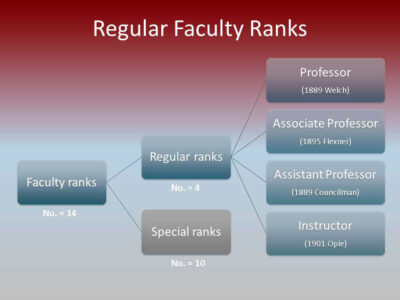
2. Faculty Rank: The School of Medicine of the Johns Hopkins University recognizes 2 types of ranks: regular ranks and special ranks, as detailed in the Gold Book.
Regular ranks include 4 levels of increasing prestige and thus salary:
- Instructor
- Assistant Professor
- Associate Professor
- Professor
Faculty members in these ranks are typically full-time, but can also be part-time or limited full-time. The first pathologists to be featured in the 4 regular ranks are indicated in the chart below.
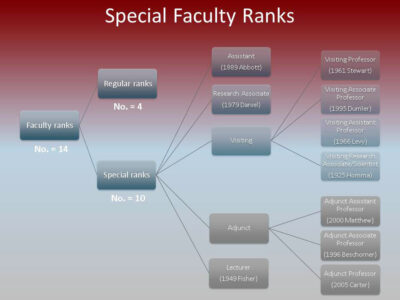
Special ranks include 5 categories and a total of 10 ranks:
- Assistant
- Research Associate
- Visiting (Scientist, Assistant Professor, Associate Professor, Professor)
- Adjunct (Assistant Professor, Associate Professor, Professor)
- Lecturer
"Assistant" refers to junior faculty members right after training (residency or fellowship) who are involved mainly in clinical activities.
"Research Associate" refers to junior faculty members right after training who are involved mainly in research activities.
"Visiting" ranks are for outstanding scientists, educators, and/or clinicians who contribute to the scholarly activities of the School of Medicine. They are solely full-time appointments, issued in 12-month terms, renewable but with no commitment for appointment to the permanent faculty.
"Adjunct" ranks are also for outstanding scientists, educators, and/or clinicians who contribute to the scholarly activities of the School of Medicine, and are also issued on a year-to-year basis. But they are solely part-time appointments. Adjunct faculty members do not receive base salary, are excluded from promotions, and are not eligible for the JHU Benefits Plan. They typically receive compensation or an honorarium for services rendered to the School of Medicine.
"Lecturer" refers to scholars who are not part of the Johns Hopkins University but come to the University to teach and share their knowledge.
The first pathologists to be featured in the 10 special ranks are shown in the chart below.
Sources
Data for Pathology faculty members was derived from these sources:
- "Catalogue and Announcement" of the School of Medicine, published yearly in the Johns Hopkins University Circulars.
- Catalogs for academic years 1904-05 through 1934-35 are available online at https://jscholarship.library.jhu.edu/handle/1774.2/32721
- Catalogs for years 1893-94 through 1903-04 and for years 1935-36 through 2010-11 were screened from the printed collection maintained in the School of Medicine Registrar's Office
- Catalog for year 2011-12 is available online at https://www.hopkinsmedicine.org/som/alumni
- Catalogs for the most recent years are still in preparation. A list of faculty members for these years was provided by Pathology Administration.
- A departmental list prepared by Dr. William MacCallum in 1931, covering the academic years 1893-94 through 1930-31
- A departmental list prepared by Dr. Ella Oppenheimer in 1963, covering the years 1931-32 through 1962-63
Data for Pathology residents was derived from these sources:
- The MacCallum's list indicated above
- The Oppenheimer's list indicated above
- "Catologue and Announcement" of the School of Medicine for the years 1899-1900 through 1958-59
- An informal list of house staff for the Johns Hopkins Hospital covering the years 1929-30 through 1998-98, provided by the Chesney Medical Archives
- Yearly resident rotation schedule maintained in the department residency office, covering the years 1999-2000 through present
- A published list of trustees, professional and administrative staff of the Johns Hopkins Hospital covering the years 1867-68 through 1955-56, available at the Chesney Medical Archives
- Analysis of yearly departmental photographs, available in the Department of Pathology
View Summaries
Summaries of Catalog Data
Below are examples of the analyses that can be done using the data contained in the Faculty & Resident Catalog.
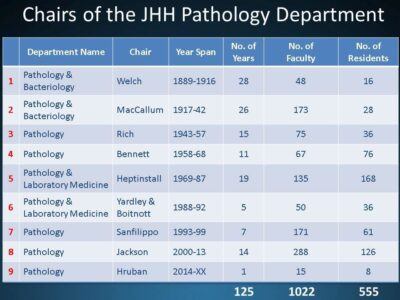
Chairmanships
Over the past 125 years the Johns Hopkins Hospital Department of Pathology has had 9 chairs (Figure 1). Dr. Welch was the first and longest-serving chair, with a record of 28 years that seems impossible to beat. Figure 1 also indicates the number of new faculty members and residents who came to the department during each chairmanship.
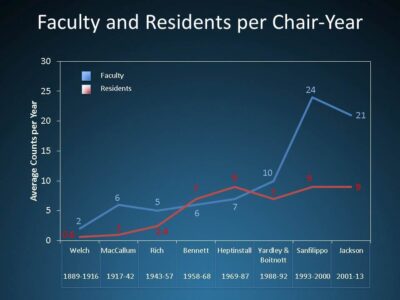
Dividing the faculty members by the number of chair years (Figure 2), it becomes clear that the biggest departmental expansion occurred during Sanfilippo's chairmanship, with an average of 24 new faculty members per year. The year Sanfilippo started as chair, 1993, is when the divisions of Anatomic Pathology and Clinical Pathology (then called Laboratory Medicine) united into one department called Department of Pathology.
Performing the same analysis for residents shows that the number of residents has been relatively stable from 1958 to present, averaging between 7 and 9 new residents per chair-year.
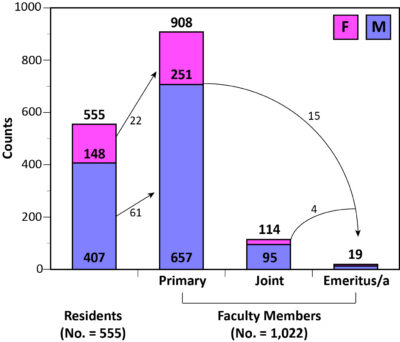
Faculty Members
From the opening of the Johns Hopkins Hospital (May 15, 1889) to academic year 2014-15, the department of Pathology has featured 1,022 faculty members (752 males and 270 females) (Figure 3). 908 (707 M, 201 F) of the faculty members held a primary appointment in Pathology, and 114 (95 M and 19 F) held a primary appointment in another department and a joint appointment in Pathology.
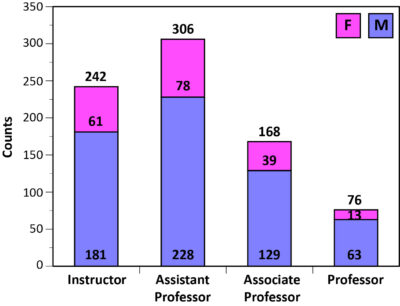
Of the faculty members, 19 (13 M, 6F) were awarded the honorary title of emeritus/emerita by the Board of Trustees in recognition of distinguished service and achievement.

The 908 primary faculty members encompassed a total of 1,411 ranks. Of these, 792 were in the regular ranks of Instructor, Assistant Professor, Associate Professor, or Professor (Figure 4), and 619 in the special ranks of Assistant, Research Associate, Visiting, Adjunct, or Lecturer (Figure 5). Of the 76 Professors, 16 were hired as Professor, and 60 rose to the rank of Professor while in the department.
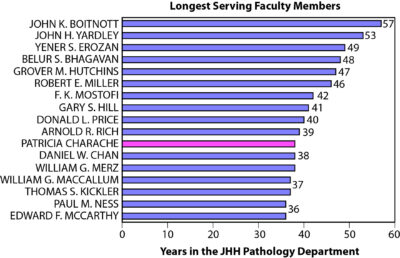
The faculty members (emeritus years excluded) who served the greatest number of years are shown below (Figure 6).
When analyzing the promotions of the primary faculty members in the regular track (Instructor, Assistant Professor, Associate Professor, and Professor) we identify a total of 305 promotions during the past 125 years.
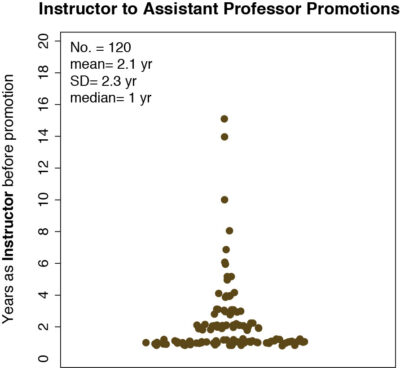
120 from Instructor to Assistant Professor (Figure 7)

125 from Assistant Professor to Associate Professor (Figure 8)
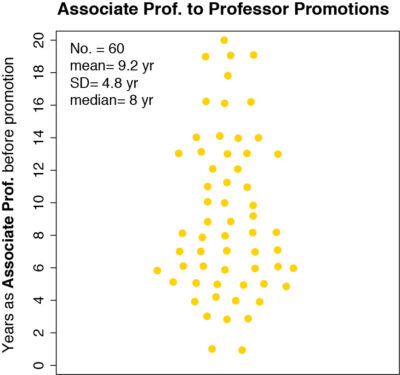
and 60 from Associate Professor to Professor (Figure 9)
The average time for promotion to Assistant Professor was 2.1 years (median 1, minimum 1, maximum 15 years), for promotion to Associate Professor was 5.7 years (median 5, minimum 1, maximum 15), and for promotion to full Professor was 9.2 years (median 8, minimum 1, maximum 20).
Residents
In January 1890, less than a year after the opening of the Johns Hopkins Hospital (May 1889), Dr. William Osler, first Physician-In-Chief (May 1889 - June 1905), proposed to the Advisory Board of the Medical School the introduction of a Residency System. A copy of Osler's report, presented at the Board meeting on January 30, 1890, can be viewed here: {OPEN AS PDF}. Osler's residency system was adopted from the German training system, which permitted newly graduated physicians to spend several years living in the hospital to perfect their training. As in the German system, early residents at Hopkins remained for several years (for example, Thayer was a resident for 7 years in Medicine and MacCallum for 10 years in Pathology). In fact, during his 16 years at Hopkins, Osler trained only five Medicine residents (Henry A. Lefleur, William S. Thayer, Thomas B. Futcher, Thomas McCrae, and Rufus I. Cole). The chiefs of the other two clinical services, William S. Halsted for surgery and Howard A. Kelly for gynecology, promptly agreed with Osler's recommendation and selected their first residents. The first five resident surgeons were Frederick J. Brockway, Hardy Phippin, William H. Baltzell, Joseph C. Bloodgood, and Harvey Cushing. The first five resident gynecologists were Hunter Robb, Albert L. Stavely, William W. Russell, John G. Clark, and Thomas S. Cullen. The Pathologist-in-Chief, William H. Welch, also agreed with Osler's proposal of a residency system since he was already using a similar type of training called fellowship in his Pathological Laboratory even before the opening of the hospital.
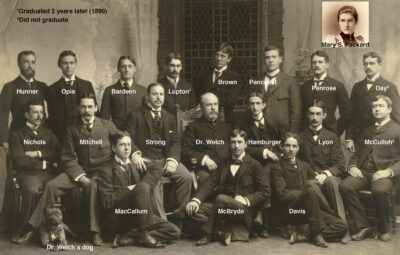
The first medical school class began courses on October 2, 1893 and graduated 15 physicians on June 15, 1897 {picture on right}. By that time, the residency training system was in place and ready to accept the newly graduated residents. The first Hopkins residents appeared in the Johns Hopkins catalog for the academic year 1899-90, the official start of the residency system at Johns Hopkins. The residency approach quickly spread across America. Many scholars consider the introduction of a residency system the greatest contribution of Dr. William Osler to medicine.
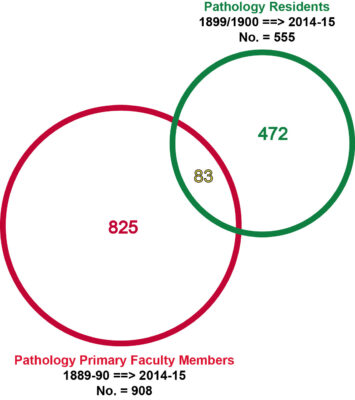
From academic year 1899-1900 to 2014-14, the JHH Department of Pathology has trained 555 residents, 407 males and 148 females (Figure 10).
Of the residents, 83 (61 M and 22 F) stayed on as faculty members for two or more years. Therefore, the probability for a resident of becoming a faculty member is about 15% (83/555 = 14.9%); and the probability for a pathology faculty member of having done the residency at Hopkins is about 9% (83/908 = 9.1%).
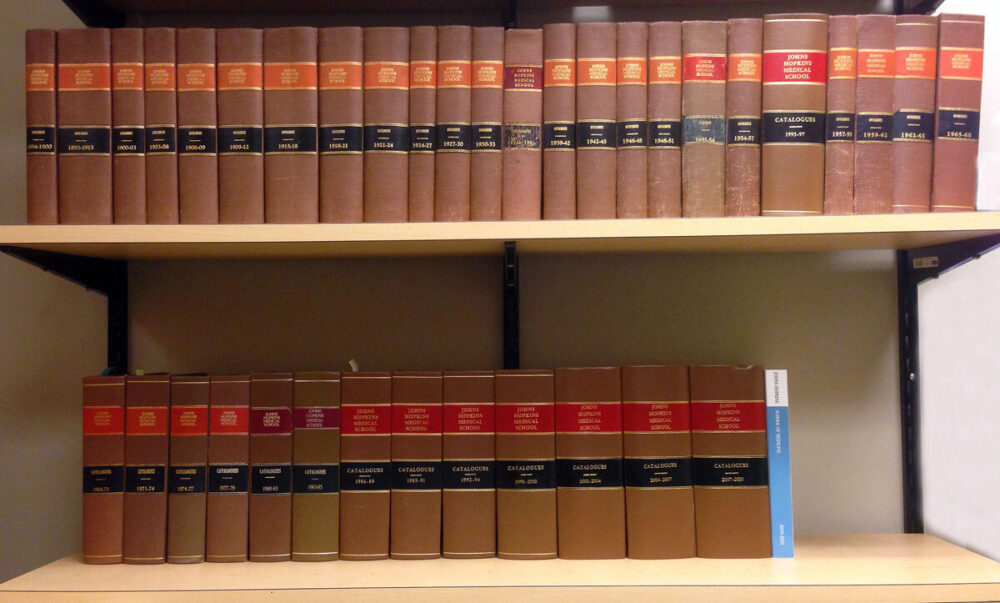
We welcome your feedback. Please direct questions and comments to: [email protected]
